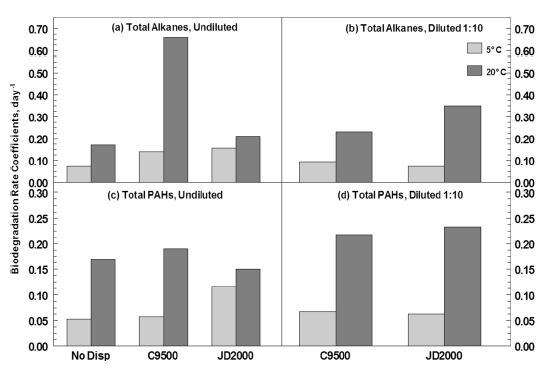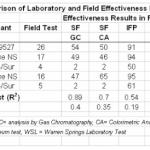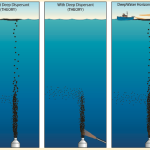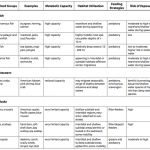![]() Promoting microbial degradation of oil has been one of the main arguments in favor of dispersant use. Interestingly, the PWSRCAC review (covering literature from 1997-2008) did not identify any recent study that explicitly found dispersant use enhancing the biodegradation of oil. Actually, ~50% of studies found that chemical additives inhibited microbial degradation and the other half of studies didn’t find any significant difference between treatment and control groups. Worryingly,
Promoting microbial degradation of oil has been one of the main arguments in favor of dispersant use. Interestingly, the PWSRCAC review (covering literature from 1997-2008) did not identify any recent study that explicitly found dispersant use enhancing the biodegradation of oil. Actually, ~50% of studies found that chemical additives inhibited microbial degradation and the other half of studies didn’t find any significant difference between treatment and control groups. Worryingly,
It is also noted that the most toxic components of the oil, the biodegradation of PAHs [Polyaromatic Hydrocarbons], has never been shown to be stimulated by dispersants. (Fingas, 2008)
Apparently, only the old skool research supported this promotion of oil biodegradation. But science is like fashion—research trends change as time progresses and we learn from our mistakes (and despite a resurgence in 80s trends, parachute pants and stretch stirrup pants were DEFINITELY mistakes). Older studies showed enhanced results because they were carried out under ideal lab conditions—high energy tanks containing lots of yummy nutrients and plenty of time for microbes to work their magic. In the open ocean, microbial growth is restricted by the limited availability of many key nutrients. In a real oil spill, time is of the utmost importance, and oil needs to be contained, removed or degraded as soon as possible.
What is clear from these studies is that the interactions between bacteria, oil, and dispersants are very complex. Yoshida et al. (2006) reported differential responses of bacterial species—some groups were able to utilize dispersant components as nutrient sources, while the growth of other bacteria was directly or indirectly prohibited. Thus, biodegradation is highly dependent on the dispersant formula, the in situ microbial community structure, and the specific type of oil being degraded.
Finally, I cannot stress enough that biodegradation is HIGHLY affected by temperature—Ventosa et al. (2004) reported rapid oil degradation at 20°C but much slower microbial breakdown at 5°C. Dispersant use = Deepwater oil plume = slooooooow biodegradation in cold, deep waters.

References:
Fingas, M.F. (2008). A Review of Literature Related to Oil Spill Dispersants 1997-2008 Prince William Sound Regional Citizens’ Advisory Council (PWSRCAC) Report PWSRCAC Website
Venosa AD, & Holder EL (2007). Biodegradability of dispersed crude oil at two different temperatures. Marine pollution bulletin, 54 (5), 545-53 PMID: 17316707
Yoshida A, Nomura H, Toyoda K, Nishino T, Seo Y, Yamada M, Nishimura M, Wada M, Okamoto K, Shibata A, Takada H, Kogure K, & Ohwada K (2006). Microbial responses using denaturing gradient gel electrophoresis to oil and chemical dispersant in enclosed ecosystems. Marine pollution bulletin, 52 (1), 89-95 PMID: 16202430
Share the post "Dispersants! Part III: Do dispersants really promote degradation of oil?"






2 Replies to “Dispersants! Part III: Do dispersants really promote degradation of oil?”
Comments are closed.